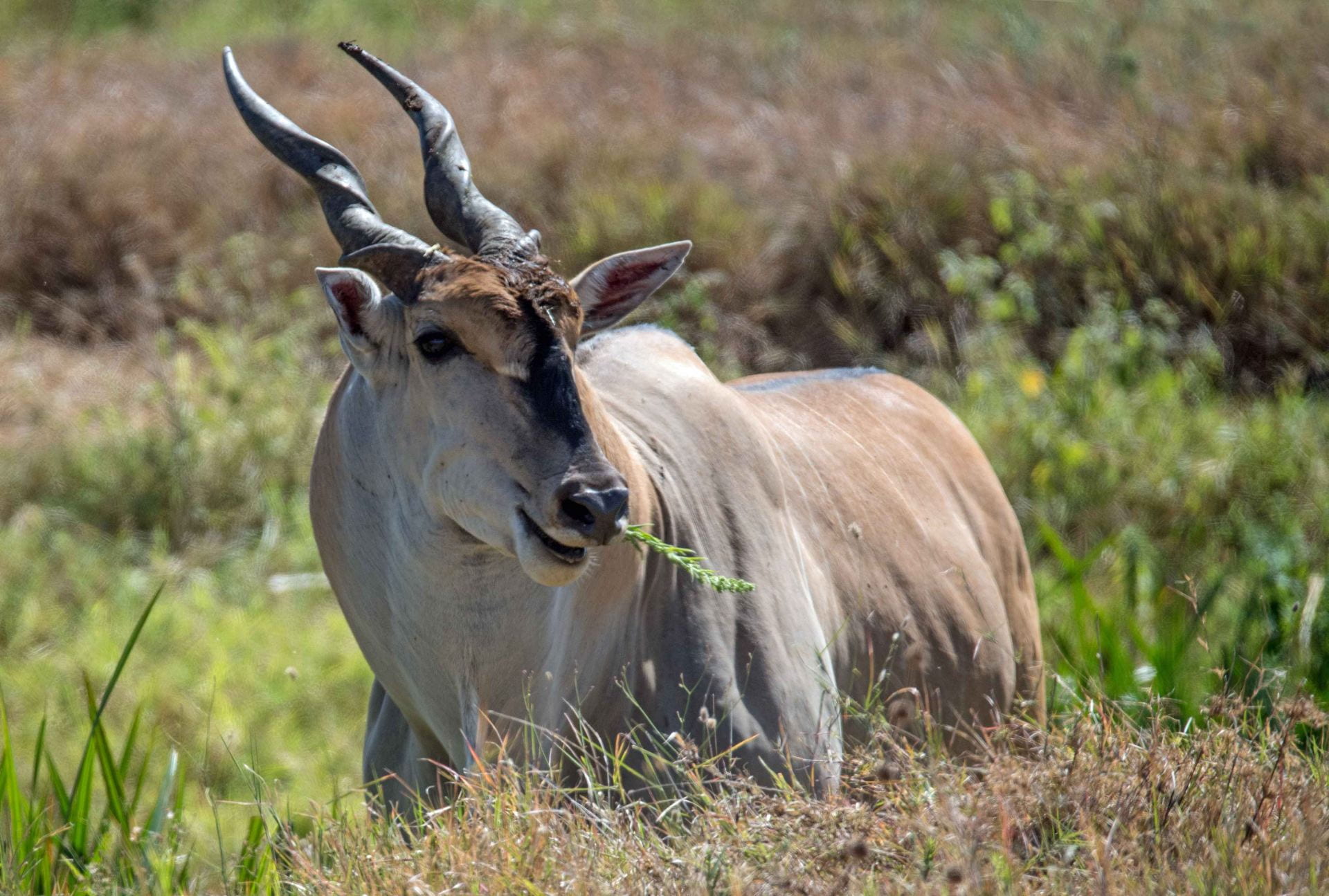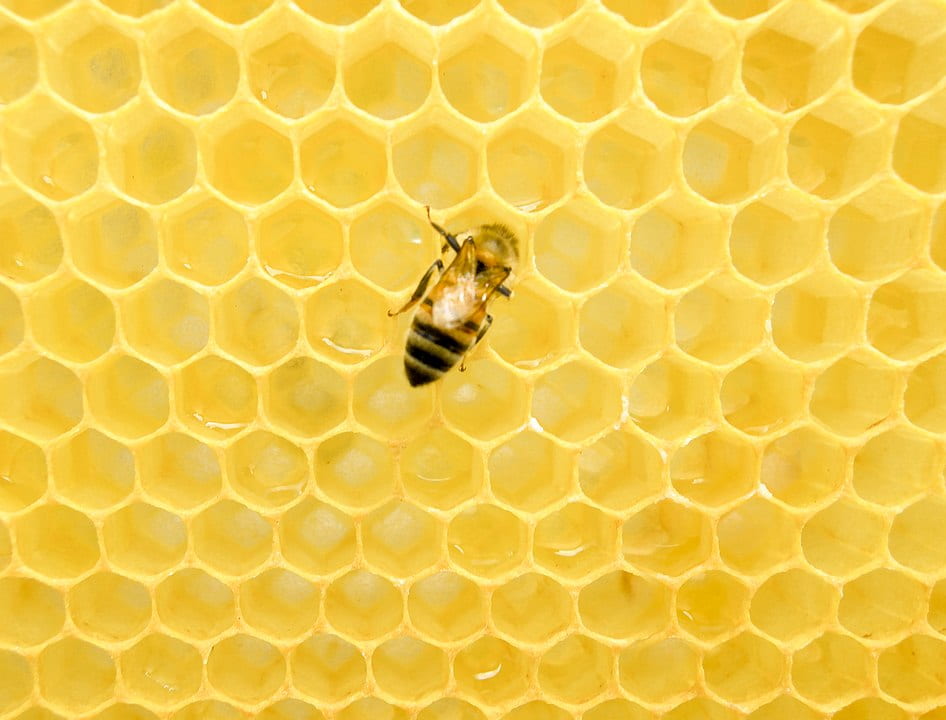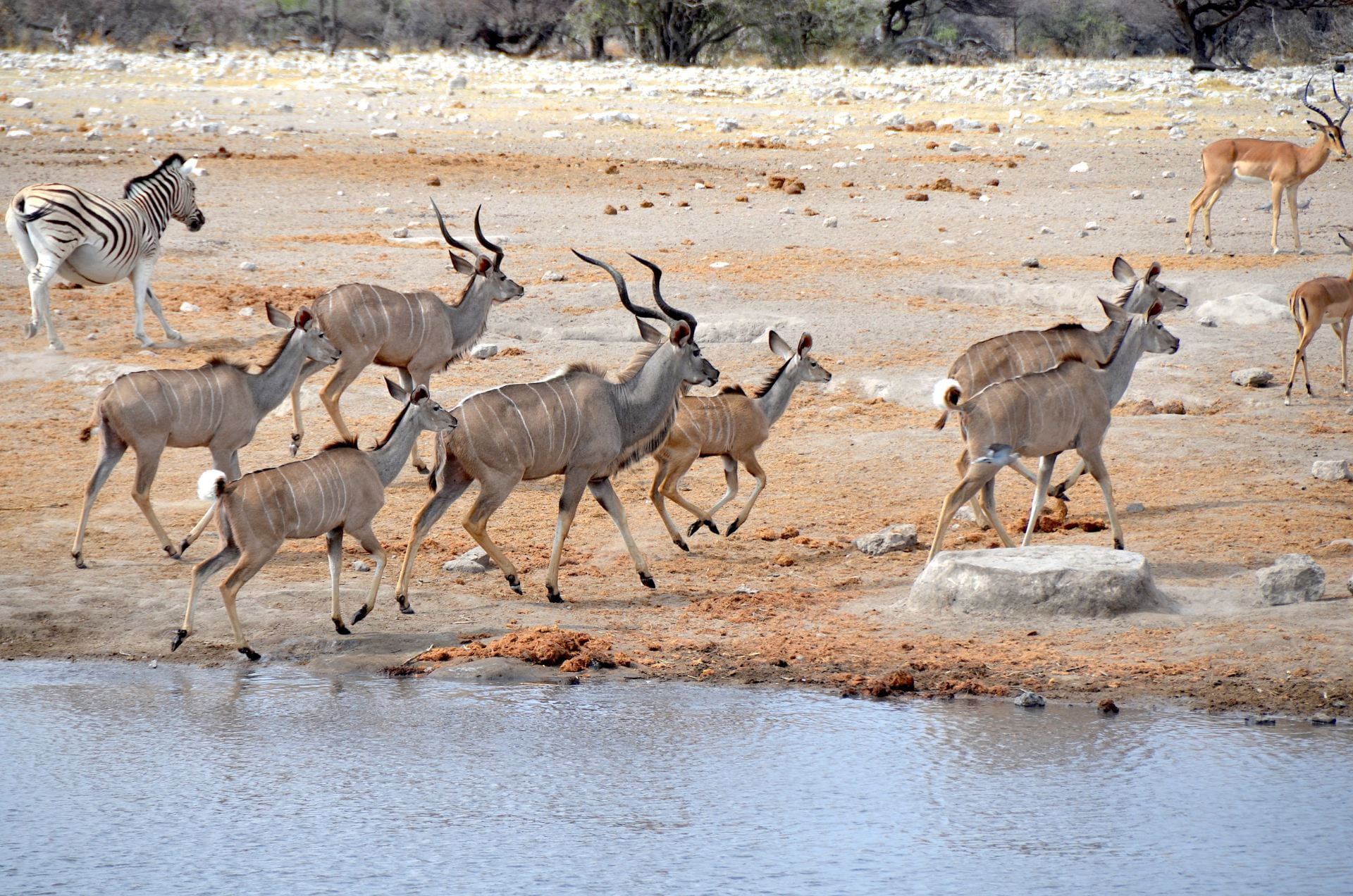“How the Mantis Gave the Bucks Their Colors”
Culture: |Xam | Narrator: Dia!kwain (David Hoesar) | Source: Bleek, Lloyd, & Bleek (1924:10)
Entry by Michelle Scalise Sugiyama
Story
The Gemsbok once ate liquid honey which is white. This is why he is white. The Mantis once gave some of it to the Gemsbok.
The Hartebeest was the one to whom the Mantis once gave some of the comb of young bees; that is why the Hartebeest is red, because the comb of young bees which he ate was red. So he became like the comb of young bees.
The Eland was the one to whom the Mantis once gave some wasps’ honey; this is why he is dark, because he once ate wasps’ honey.
The Quagga was the one to whom the Mantis once gave some of the small bees’ honey; that is why he is dark, because he ate the small bees’ honey. So he is dark.
The Springbok was the one who once ate the liquid from the young bees’ cells; that is why he is red. The Mantis squeezed it out for him and he drank. That is why he is red.
These little bees when chewed are white like milk, but they were still in their cells which were red. The Springbok ate the squeezed-out liquid of the bees and the cells together.
Traditional Ecological Knowledge
Zoology
This story describes the color of five ungulate species: the gemsbok is “white,” the hartebeest and springbok are “red,” and the quagga (now extinct) and eland are “dark.” These differences are attributed to the color of the honey or honeycomb that the Mantis once gave them (in Distant Time). In the present world, these animals do not eat these foods. However, by associating each of them with a different type of honey or honeycomb–which are part of the San diet and thus familiar to them–the story provides a vivid picture of the animals’ coloring. The gemsbok is the color of liquid honey, the eland is the color of wasps’ honey, and so on. The information that the springbok ate both the red cells and the white chewed-up bees may refer to the fact that part of this animal’s body is reddish-brown and part of it is white. These five ungulates are similar in size, morphology, habitat, and certain behaviors. Four of them are antelopes (Bovidae) and thus have horns, four are herding species, and all are fleet of foot. These similarities might make it difficult for hunters to identify them at a distance; knowing their color may aid in this task. Identification is crucial because these species also differ from each other in important ways. These differences call for different hunting strategies. Hartebeests, for example, are very alert and cautious compared to other savanna ungulates. They depend largely on vision to detect predators, take turns acting as sentinels, and give warning snorts at the approach of danger.
Gemsbok | Photo by Yathin S Krishnappa
Hartebeest | Photo by Kevin Folk on Unsplash
Eland | Photo by David Clode on Unsplash
Springbok | Photo by Chris Stenger on Unsplash
Because honey production requires flowers, associating these ungulates with honey may encode information about the time of year they are present. Springbok, for example, are migratory and eat flowers; thus, the story may indicate that they pass through San territory when flowers are blooming and the young bees are still in their cells. The story may also encode information about life history and seasonal fluctuations in weight. The springbok, quagga, and gemsbok reproduce during the rainy season or when sufficient water is available. Thus, blooming flowers and honey availability may indicate that these species are currently raising young and/or have adequate fat stores to make hunting them worthwhile. The story also indicates that some bee and wasp species produce edible honey, that the comb of young bees is red, and that “little bees” are edible.
Mantis | Photo by Dustin Humes on Unsplash
Cultural Geography
This story also references food sharing and gift giving. The Mantis gives a different type of honey or honeycomb to each of the five ungulate species; thus, the act of sharing is referenced five times over the course of this relatively short story. In oral storytelling, repetition is often used to call attention to important information or to make an important point. Thus, the Mantis’ actions appear to model an important norm or value in San culture: without directly saying so, the story implies that it is customary to be generous and share food with others.
Technology
This story also provides a bit of information about food processing, noting that the liquid in the honeycomb cells can be accessed by squeezing: “The Springbok was the one who once ate the liquid from the young bees’ cells. . . . The Mantis squeezed it out for him and he drank.”
Photo by Matthew T Rader
The Land and The People
Kalahari Desert | Photo by Thomas Evans on Unsplash
The |Xam people are among the first nations of Southern Africa. These peoples are often referred to collectively by the exonyms San or Bushmen, but prefer to be identified by their individual endonyms. The |Xam people spoke the (now extinct) |Xam dialect of the !Kwi language cluster of the Tuu language family. The |Xam and other hunter-gatherer peoples have lived in Southern Africa for thousands of years. As colonial settlement expanded in the eighteenth and nineteenth centuries, they were driven north, and found refuge in the Kalahari Desert, an area of roughly 350,000 square miles. Here they continued to live by hunting and gathering into the twentieth century.
The Kalahari is a flat, sandy plain dotted with shrubs and trees, and broken by dunes, hills, bare rock, and dry river beds that contain flowing water only once or twice a decade. Summers are hot, with a four-to-six-month rainy season; winters are dry and mild, although nighttime temperatures often drop to freezing. Annual precipitation can vary by as much as 500% and droughts are frequent. Water scarcity was thus a major problem, and |Xam life was accordingly nomadic. The people had to move camp frequently, because water and plant resources near camp were quickly exhausted. For the same reason, the |Xam and related groups tended to live in small bands ranging from 20 to 50 people, depending on the season.
“The eland antelope . . . is the San’s preeminent game animal. . . . Docile, massive (weighing as much as a ton), an eland bull, wounded with a slow-working poison arrow, may take days to expire, while being tracked and stalked, brought to bay and dispatched at close quarters. Hunting eland—along with other big game antelope species such as hartebeest and wildebeest, gemsbok or kudu—is . . . an intense interspecies encounter.”
—Guenther (2017:4)
Ungulates were important in the diet, and highly prized for their meat and hides. A variety of “bucks” were hunted, including gemsbok, eland, hartebeest, kudu, wildebeest, giraffe, and roan antelope. Gemsbok and hartebeest skins were used for clothing, and gemsbok stomachs were used for water bags. The Ju|’hoansi people, who lived to the north of the |Xam, greatly enjoyed reciting the names of the animals—especially large game species. This custom would have familiarized children with the animals in their environment, much as the ABC song teaches English-speaking children the alphabet.
Eland | Photo by Yathin S Krishnappa
“Ju/’hoansi enumerate the animals, especially the large meat animals . . . in folktales or in ordinary conversation . . . in a highly stylized, almost rhapsodic fashion . . . . putting successive fingers up to their lips as each animal’s name is called. . . . The list becomes a singsong. Almost, the eyes glaze over . . . . People love to do it, and they count off the animals at every opportunity.”
—Biesele (1993:60-61)
Among Southern African foragers, plant foods and small game are shared within the family, whereas large game animals are shared with everyone present in camp. This includes eland, kudu, gemsbok, wildebeest, hartebeest, springbok, warthog, ostrich, buffalo, and giraffe. There are strict rules for dividing up meat. The owner of a kill is the owner of the first arrow to penetrate deep enough for the poison to take effect. The owner of the arrow is not necessarily the hunter who used it: hunters acquire arrows by making them, receiving them as gifts, or borrowing them. A hunter chooses which arrow to use depending on whether or not he wants to be responsible for distributing the meat. A kill is first distributed among the owner of the arrow and the members of the hunting party. These people then distribute the meat to their consanguineal and affinal kin, who in turn share with their kin and any visitors present.
Map
The traditional homeland of the |Xam people is the Kalahari Desert, an area of 350,000 square miles.
References
Barnard, J. (1999). “Antidorcas marsupialis.” (On-line), Animal Diversity Web. Accessed November 2020 at https://animaldiversity.org/accounts/Antidorcas_marsupialis/.
Batty, K. (2002). “Alcelaphus buselaphus.” (On-line), Animal Diversity Web. Accessed November 2020 at https://animaldiversity.org/accounts/Alcepaphus_buselaphus/.
Bleek, D. (1928). The Naron. Cambridge: Cambridge University Press.
Bleek, W., Lloyd, Lucy, & Bleek, D. F. (1924). The Mantis and His Friends. Cape Town, London and Oxford: T. M. Miller and B. Blackwell.
Fahey, B. (1999). “Taurotragus oryx.” (On-line), Animal Diversity Web. Accessed November 2020 at https://animaldiversity.org/accounts/Taurotragus_oryx/.
Lee, R. (1984). The Dobe !Kung. New York: Holt, Rinehart and Winston.
Marshall, L. (1961). Sharing, talking, and giving: Relief of social tensions among !Kung Bushmen. Africa: Journal of the International African Institute, 31(3), 231-249.
Rodriguez, D. (1999). “Equus quagga.” (On-line), Animal Diversity Web. Accessed November 2020 at https://animaldiversity.org/accounta/Equus_quagga/.
Sanders, S. (2005). “Oryx gazelle.” (On-line), Animal Diversity Web. Accessed November 2020 at https://animaldiversity.org/accounts/Oryx_gazella/.
The Digital Bleek and Lloyd. http://lloydbleekcollection.cs.uct.ac.za/index.html














